


Figure 1. Saint Nicholas of Myra Refusing Milk, ivory crozier, Victoria and Albert Museum, London (1150-1185).
December 6 marks the feast day of Saint Nicholas of Myra, the source of our modern-day Santa Claus. We have taken this occasion to showcase the Index of Medieval Art as a tool for learning and researching about the iconography of medieval saints. The Index’s extensive collection of data had already offered users a chance to trace the saint’s history through art, and its archive of medieval images had granted researchers the opportunity to compare iconographies and expand their understanding of saints like Nicholas. Now, the multiple filters in the new database, currently in beta and undergoing daily refinements, allows users to retrieve, browse, and narrow search results in order to highlight the specificities of the saint.
The historical Saint Nicholas of Myra is an obscure figure. We know little more than that he was born in Asia Minor at the end of the third century and later in his life became a bishop of Myra. Nevertheless, he is one of the most popular saints of the Christian church, praised for his victories against demonic infanticide and his capacity of resuscitating dismembered bodies left in barrels to cure (yes, that’s right!). It should really come as no surprise, then, that the Index has 376 records of portraits and more than 600 representations of narratives and single figures of the saint.
But, if Nicholas’s life is virtually unknown, how did his cult and imagery develop to such a degree? The medievalists among our readers will already know that that the answer lies in another Saint Nicholas, that of Sion. The latter lived in the sixth century, and we have somewhat more information about him. Before the 10th century, these two saints, Nicholas of Myra and Nicholas of Sion, were merged by the literary tradition, and the voids left by the life of the former were filled by the latter. The fate of the two saints was sealed, and the archimandrite of Sion fell into darkness while the cult of the bishop of Myra flourished.
The cult of the bishop of Myra spread in both Eastern and Western Christendom. His life is represented in Byzantine monumental painting at least 31 times. The strengthening of his devotion saw a similar trend in the West. By the Renaissance, he had become the most popular saint in Europe. The Index allows for an interesting overview of the different contexts where Saint Nicholas’ cult developed. By browsing the Style/Culture filter, you can find 355 records identified as Gothic, 161 as Byzantine and 89 as Romanesque.
We know very little about Saint Nicholas’ childhood, but the Golden Legend assures us that he was incredibly pious from birth (literally):
While the infant (Saint Nicholas) was being bathed on the first day of his life, he stood straight up in the bath. And from then on, he took the breast only once on Wednesdays and Fridays.
On a Crozier at the V&A, Saint Nicholas is represented sitting on his mother lap (Fig.1). She is offering her breast, but Saint Nicholas refuses, averting his head. With such a start, we should not be surprised that, as a young man, he decided to devote his inheritance to saving three sisters from prostitution (a real-life super hero!). The opportunity arose when a citizen of Myra lost all his money and could not support his three daughters. Nicholas heard of the situation and provided a dowry for each of the sisters. Among the 58 records with this subject identified in the Index database is a fresco in the chapel of Saint Nicholas in the lower church of San Francesco in Assisi (Fig.2). Here, he is represented as throwing three bars of gold through the window of a building where the three sisters and their father are sleeping.

Figure 2. Nicholas of Myra aiding the Dowerless Maidens, detail from the Chapel of Saint Nicholas, San Francesco, Lower Church, Assisi (1300-1349).
The nature of the dowry in this tale ranges from bags to balls to bars to coins of gold. In western iconography, the three balls become an attribute of the saint, and scholars have suggested a link between this and the pawnbroker’s symbol of three golden spheres suspended from a bar.
Besides helping maidens, Saint Nicholas is also known as the guardian of sailors, an exorcist and healer. By using the Creator filter in the Index, it is possible to examine this dimension of Saint Nicholas’s through the eyes of many artists. Ambrogio Lorenzetti, for instance, painted on panel several scenes from the life of the Saint, including that of the Resurrection of the Strangled Boy (Fig.3). The scene takes place in a two-story house, with the narrative beginning on the upper floor with the banquet scene. During the feast, the devil came to the door, dressed as a pilgrim and asking for alms. The boy is represented first at the top of the stairs, answering the door, and later at the bottom while being strangled by the devil. The story continues to unfold in the foreground where the boy is resurrected by the rays descending from Saint Nicholas.

Figure 3. Saint Nicholas of Myra Resurrecting a Strangled Boy by Ambrogio Lorenzetti. Panel painting in the Uffizi Gallery, Florence (1300-1349).
Purely western is the peculiar story of Nicholas’s resurrection of three murdered boys. According to this tale, an innkeeper kidnapped and killed three youths. In the stained-glass window from Bourges Cathedral, they are shown reclining on a draped bed as the innkeeper raises his ax to kill them (Fig.4). At far right, Saint Nicholas extends his right hand in blessing toward the resuscitated boys, reflecting the legend’s account in which the innkeeper, having chopped up the boys, placed them in a barrel to cure. As an explanation for this, it is said that there was a famine during that year, and so the innkeeper was hoping to sell the cured meat as ham in order to make a living (sure, that makes total sense).

Figure 4. Saint Nicholas of Myra Resurrecting the three murdered boys, detail of a stained-glass window from the Chapel of Saint Nicholas, Bourges Cathedral (1205-1220)
The range of stories and miracles performed by Saint Nicholas developed with the saint’s reputation as a healer and the protector of children, unmarried girls, merchants, sailors, pawnbrokers and scholars. His popularity overall is reflected in the Index. Using the Work of Art Type filter, you’ll discover that because of this widespread cult, Saint Nicholas can be found in 169 manuscripts, and on 22 painted panels, 4 book covers, 2 miters, and 1 ring. Similarly, by browsing the Medium filter, we learn that there are 140 instances of depictions of Saint Nicholas in fresco, 37 in embroidery, 17 in mosaic, 15 in ivory, 8 in enamel, and 2 in niello.
It is only fitting that we should end with the death of Saint Nicholas, from whose remains a fragrant oil was said to flow, an oil that performed many miracles. But the story doesn’t really end here. Saint Nicholas’ body was stolen in the 11th century by Italian merchants and brought to Bari where it has been kept ever since. However, recent archaeological excavations in the church of Saint Nicholas in Demre (once known as Myra) have brought to light an intact tomb (soon to be opened) beneath the floor. Some believe this to be the original tomb of Saint Nicholas. If there’s a body in this tomb, does that mean that the relics in Bari are not of the saint after all?
We hope that by exploring images of Saint Nicholas in our database, you’ll also discover the many ways in which the new Index of Medieval Art can help you with your research. The database offers users the opportunity to expand and challenge previously acquired knowledge using new (still developing) filters that aid in narrowing the search thematically, iconographically, and stylistically. We have plans for other features as the beta continues to develop (though, not always as fast as we would like) offering new tools for discovery. And although this ongoing, expansive repository called the Index of Medieval Art does not hold all the answers, we hope that it will prompt you to ask more questions.
Maria Alessia Rossi, Kress Postdoctoral Researcher
As our regular readers know, the Index of Medieval Art recently launched a redesigned database. A challenging part of preparing for this event (codenamed Project Phoenix) was revisiting, reevaluating, and often revising how the Index has traditionally presented certain types of information. A century of accumulated data can reveal some unexpected things. Since the Index was founded in 1917, the history of the world has been…oh, let’s just call it “eventful.” Perhaps it shouldn’t be surprising, then, that the process of updating our outdated records as we upgrade the Index database has been a sobering reminder of all that has changed in the world, all that we have learned and achieved, and all that we have lost over the last one hundred years.
One set of data that made the need to revise our records very clear to us was the place names that we use. Obviously, names change, but we can point to a variety of reasons for the outdated information in the Index database. Some names in English are translations from the language of the place in question. In English usage, Wien remains Vienna, and Firenze remains Florence, but Lyon has superseded Lyons. Sometimes it’s a question of both language and script. What rules of translation and transliteration should we prefer? Depending on who is speaking or writing, a single place can be known by many names. For example, the Armenian place name Հռոմկլա can be transliterated as Hromkla, Hṛomkla, Hṛomklay, or Hrongla, but it can also be Rum Kalesi, Rūm ḳal‘esi, Rumkale, Qal‘ah Rumita, Qal‘at al-Rum, Qal‘at al-Muslimin, or Kela zêrîn. Can a single rule be applied consistently and make sense to users of the Index?
No matter the topic under discussion among the research staff at the Index, the answer to that last question turns out to be “no” frustratingly often. Language, like the rest of the world, is just too messy. One of our solutions, at least regarding how we handle locations, has been to embrace the messiness so that we simply have to account for complexity. So, when choosing an authority to cite for place names (authorities such as the Getty Thesaurus of Geographical Names and the Library of Congress, among others), we quickly decided that we need not cite the same authority in every case.

In addition to the problem of language, there are also outright changes of name that we have to recognize. The city of Byzantium has gone by a few different names in its history (Fig. 1). It’s called Istanbul now, but Istanbul was Constantinople. Now it’s Istanbul, not Constantinople. Believe it or not, that change became official many years after the Index was founded. It’s also worth mentioning that, although the name of that city should really be spelled “İstanbul” in Modern Turkish (with a dotted capital “İ”), the Index will continue to use the spelling familiar to English readers. Thus, even for something in situ, the database might list different names for an object’s or monument’s location of origin and its current location. Hagia Sophia is in Istanbul, but it was in Constantinople. (Have we given you an earworm yet?) Nevertheless, as we update the Index database, we will cross-reference place names so that, for example, a search for Istanbul (or İstanbul) will always also lead you to Constantinople.
But it’s not only names that change. Borders also sometimes shift. Once upon a time, when the Index was new, the city of Königsberg was in Prussia. After World War I, Königsberg was part of Germany (the Weimar Republic, that is, and then Nazi Germany), and by the end of World War II, much of the city had been destroyed, including museums and medieval monuments. That makes Germany the last known location for those buildings and the objects they contained (Fig. 2). Once the Prussian home of Immanuel Kant, Königsberg is now within the Russian exclave between Lithuania and Poland. And, oh yes, it’s called Kaliningrad now. Our goal at the Index of Medieval Art is to continue to update our database to account for such changes.
By the way, for those of you as interested in topology as you are in topography, Kaliningrad was—when it was Königsberg—the subject of a famous logic puzzle. The city straddles the Pregel River, and there are two islands in the river, a feature reminiscent of Paris. The islands in Königsberg were connected to the rest of the city, but the bridges were configured in such a way as to give rise to this puzzle: “Can you walk through Königsberg crossing each of the seven bridges only once?” This puzzle has rules, of course: you have to cross each bridge only once, and you must cross each bridge completely (without turning around in the middle), but you may not cheat with a boat or hot air balloon. The puzzle was solved in the 18th century by Leonhard Euler, the great Swiss mathematician and general smarty-pants. When it comes to walking through Königsberg, crossing each of the seven bridges only once, Euler proved that…spoiler alert…it couldn’t be done!
Time does things to maps. Not only do place names change and frontiers shift, but cities rise and fall, roads are rerouted or renamed, and buildings are razed or rebuilt. Sometimes new bridges replace old ones, so that even that famous logic puzzle about the seven bridges of Königsberg has been affected by the last two centuries of human history. Only two of the bridges that Euler knew still exist, and the new configuration of bridges means that the Königsberg puzzle is no longer a puzzle at all in Kaliningrad!
On a related note, have you ever wondered, “When is a map not a map?”

More precisely, the question that arose recently at the Index was this: “When is a map a map, and when is it a representation of a map?” Questions like this one can lead to surprisingly lively discussions at the Index of Medieval Art. This particular question came up while we were discussing how the Index ought to categorize certain subjects. It seems clear that some things are maps, like the Hereford Mappa Mundi. It also seems clear that some images include representations of maps, without actually being maps (Fig. 3).

However, some cases may be less clear, like a map in the Turin Beatus (Fig. 4). Is this an illumination that consists of a map, or is it a representation of a map? In other words, when is an object a map, and when is “map” the subject of an image?
What we at the Index sincerely hope is that you, everyone who uses the Index, will join us in addressing such questions. We invite subscribers to try out the Project Phoenix beta to see what we’ve been working on. We welcome your thoughts, so please tell us about your experience using the database, or share your observations about how we handle the content. Please bear in mind that this is the beta stage of development, so not everything is working perfectly yet. Some features have not been fully implemented, and some may be disabled from time to time while we work to improve them. It will also take us some time to edit the contents of the database so that everything is handled consistently within our revised format. In the meantime, the old, familiar database is still available to subscribers, and it will continue to be available until we are confident that the new version can supersede the old one.
We look forward to hearing from you. Your insights and feedback will continue to be vital to the success of this enterprise, just as they have been through the first 100 years of the Index of Medieval Art.
Henry Schilb
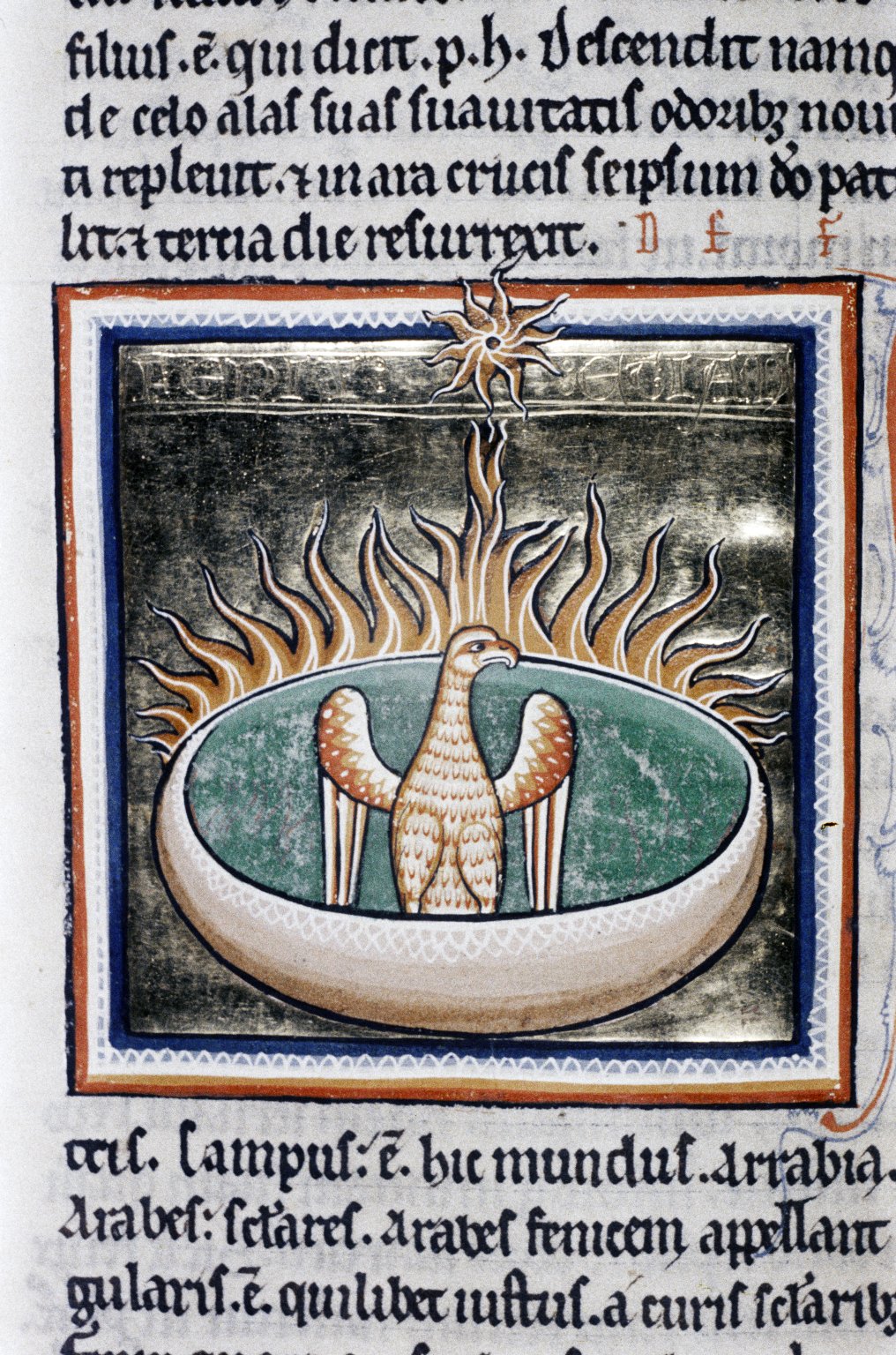
The Index of Medieval Art is proud to announce that the new database platform is now in beta. Project Phoenix is the culmination of years of planning and development in collaboration with Luminosity Labs. When we first conceived this project in the summer of 2014, we decided that we needed to develop a platform that was modular enough to build upon in the future. It was important to us that, as methods of study change, the tools we provide researchers must be able to evolve as well.
There are now more access points into our data. Our new advanced search and refinement tools will give our users much greater flexibility, so that results can be narrowed to isolate specific works of art. Users will now have the ability to target their queries with multiple factors—such as date, location, subject, media, and more—but with precise control.
The new platform also introduces a responsive design, meaning that the user interface can adapt to your device whether it is a large computer monitor or a smaller tablet. We estimate as much as 50% of our web traffic is from mobile devices such as iPads, so we are working to make sure that we can support the mobile experience.
This is just the start: we will be rolling out many additional features over the next few weeks and months. In the coming year we plan to introduce a new interface for navigating in situ works, as well as a new interface for exploring our subjects by hierarchical classification rather than keywords alone.
In 2018, we will also be implementing IIIF support for images. This will mean that works of art for which we have high-resolution images can be examined in greater detail. You will have the ability to zoom in and out, and to pan around the images, all from within our web application.
We invite you to try out our Project Phoenix beta to see what we’ve been working on. And please send us your feedback! We welcome your thoughts, but keep in mind that this is the beta stage of development, so not everything is working perfectly yet. Some features have not been fully implemented, and some may be disabled from time to time while we work to improve them.
In the meantime, the old, familiar database is still available to subscribers. This legacy database will continue to be available until we are comfortable that the new version can supersede the old one completely.
Thanks for your support and patience through these exciting times. We look forward to hearing from you about the new design!
The personification of Wisdom in medieval art is usually grouped with other virtues, such as Justice, Hope, Prudence, Chastity, Poverty, Courage and Fortitude. While she works in communion with these sisters, she also performs her own distinct role. As the story goes, Wisdom was created by God before the world existed and is therefore in the position to offer humanity knowledge that will lead to its salvation. When Wisdom speaks in the Book of Proverbs, it is often to highlight her own importance and power. She calls herself a font of knowledge and a righteous helper who will reward those who follow her instructions. Wisdom says,
“By me kings reign and lawgivers decree just things. By me princes rule and the mighty decree justice. I love them that love me, and they that in the morning early watch for me shall find me. With me are riches and glory, glorious riches and justice….” [Proverbs 8.15–18 (Douay-Rheims Bible)]

This reward of Wisdom manifests in two ways: not only does she assist in saving the souls of those who heed her message, but she also has the authority to grant earthly power to individual rulers. The Index of Medieval Art records several scenes in biblical and secular narratives in which the virtue of Wisdom is a central character. Some relevant subjects in the Index include Christ: praising God’s Wisdom; Personification: Holy Wisdom; Personification: Celestial Beatitudes; and Holy Ghost: Gifts; and in narratives, Pèlerinage: Scene, Wisdom with Aristotle; Confessio Amantis: Scene, Darius, Sultan of Persia, seeking Wisdom, and De Consolatione Philosophiae: Scene, Wisdom showing Boethius Vision of Heaven.
In some Semitic languages, the word we translate as wisdom literally meant to restrain oneself from evil, suggesting a conscious desire to avoid sin. Thus, a sinful individual cannot approach Wisdom, as illustrated in a Romanesque miniature on folio 11r in the Stammheim Missal made in Hildesheim [Los Angeles, J. Paul Getty Museum, Ms. 64 (97.MG.21)]. Flanked by David and Abraham, a crowned Wisdom (Sapientia) is positioned beneath the half figure of Christ. Here she is in direct contact with the divine as she supports with raised hands the arc of heaven, the traditional separator of realms. In a sense, she has become a gatekeeper and mediator for Christ. Surrounded by earthly men, including Zechariah and Patriarch Jacob, Wisdom can also be seen as a kind of “ladder” to heaven, since her upright body forms an important link to the promise of salvation.

Wisdom’s spiritual authority is exemplified by a scene on folio 239v of the De consolatione philosophiae of Boethius, which shows her leading the Roman philosopher to God’s throne (New York, Morgan Library, M.396). They enter through a side door of the throne room, positioning Wisdom once again as the route to the divine.
However, Wisdom also bore earthly authority, mentoring influential individuals such as Solomon, the Old Testament king of Israel and the traditional author of the biblical Book of Wisdom. This relationship is illustrated within an initial P (New York, Morgan Library, M.791). Against an ethereal gold burnished background, a veiled Wisdom crowns Solomon as a sign that she is at the root of his authority. By Wisdom—and by way of Wisdom—Solomon enacts what is so eloquently echoed in the verse of Proverbs: he will enjoy elevated status owing to the receipt of spiritual gifts; his reign is received in righteousness; and his rule is just.
This guest blog post was written by Rachel Dutaud, a summer student assistant at the Index of Medieval Art and a recent graduate in Art History and Ancient History from the University of St. Andrews. Over the 2017-18 academic year, Rachel will be working toward her MA degree in Archives & Records Management at University College Dublin. Her interests are medieval art history, iconography of female rulers, classicism, and archives.
One of the little thrills those us who do academic research get to enjoy — whether we specialize in the arts and humanities or engineering and sciences — is when our favorite topics come up in films or on television. Imagine the excitement for anyone who studies Andalusian architecture when the quasi-medieval show “Game of Thrones” received rare permission to film inside the beautiful Alhambra Palace in Granada, Spain.
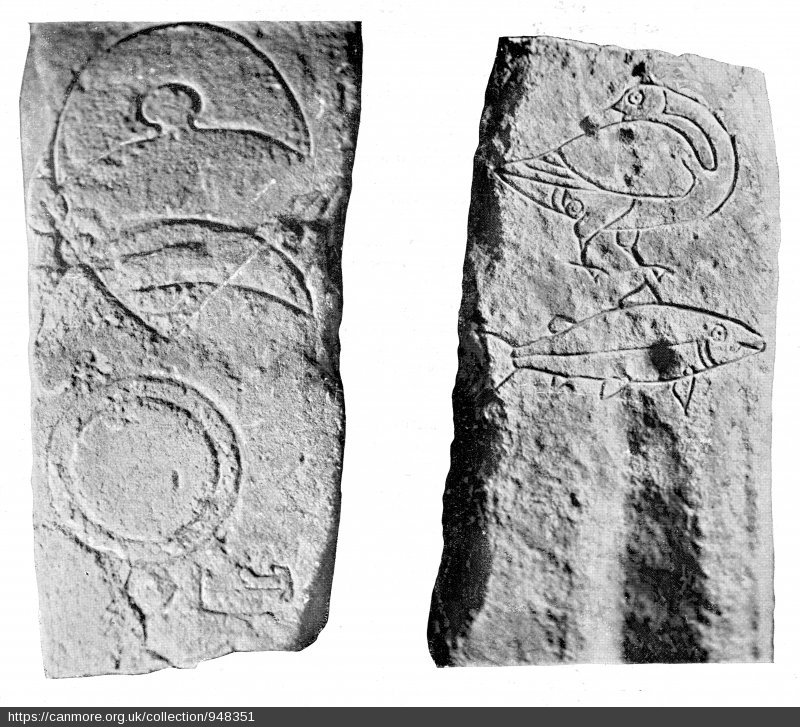
Now perhaps it will come as no surprise that several of us here at the Index of Medieval Art are looking forward to the next series of “Doctor Who” — and the premiere of the first female Doctor (to be played by Jodie Whittaker)! — when the Doctor’s complicated history with historical accuracy resumes. For those of you regrettably unfamiliar with “Doctor Who,” it is a long-running BBC show about a long-lived, possibly immortal, time-traveling alien, and history nerds are among the most avid Whovians. To understand why, just watch the episode in which Pompeii was destroyed because aliens were building a spaceship in Vesuvius! In another episode, we learned that William Shakespeare’s plays include secret spells that open portals to other parts of the universe!
In the most recent series, the episode “The Eaters of Light” took place in Scotland in the second century AD. The Ninth Roman Legion, charged with the task of defeating the “barbarians” living in ancient Scotland, disappeared without a trace. When the Doctor and his companions investigate, things get a little strange. In the second century, the Roman Empire was trying desperately to maintain control of the lands of the “Picts” who lived north of what would very soon be the site of Hadrian’s Wall. The Picts are so called because these “painted people” (Picti) are mentioned in very early medieval texts. We know almost nothing about them, other than that they were fierce warriors, they painted their bodies before battle, and they left behind large stone monuments decorated with pictographic writing.
The Index of Medieval Art has almost 250 entries for “Pictish” artwork, most of which are large stones, either stelai or crosses. The stones usually appear in pairs, and the symbols carved on them depict inanimate objects like mirrors and combs, or crescents, and other geometrical shapes, as well as animals such as horses, dogs, birds and the enigmatic “Pictish beast.” It was this Pictish beast, a creature something like a hybrid of dolphin, horse, and dragon, or even (as some have argued), the Loch Ness Monster, that was the focus of “The Eaters of Light.” The episode proposed that it was a species of lizard-like alien monster that traveled through a great stone chamber-tomb in northern Scotland. Released in order to defeat the invading imperial army, it continued eating, threatening to consume all the light in our universe. Of course!
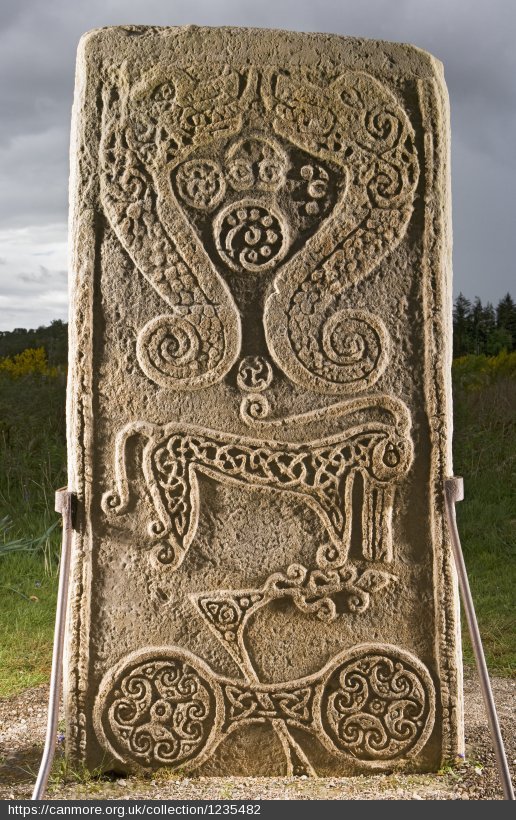
While this episode provides a fanciful interpretation of the Pictish stone carvings, it does actually highlight a point that art historians and archaeologists have been puzzling over for more than a century — just what do these symbols mean?
The stones were classified in the early twentieth century into three types, based upon their iconography and the level of detail in their carving. Class I stones, which date roughly to the fifth to seventh centuries, are relatively plain, and have only Pictish symbols inscribed upon them. Class II stones are slightly more ornate, with more effort obviously spent on not only carving the imagery but also on decorating the shape of the stone itself. They have not only Pictish symbols, but also Christian iconography such as very simple cruciform carvings. These are thought to date to the period of the seventh to ninth centuries, when conversion to Christianity was becoming more common in the region we now know as Scotland. Finally, Class III stones, which date to the later eighth and ninth centuries, are the most ornate. Their edges are highly decorated, the shape itself has been clearly hewn from the rock rather than simply incised upon it, and they have intricate carvings of knot-work and lace-work. Apparently used not only as upright markers or crosses but also as grave slabs, all of these Class III stones have explicitly Christian imagery, with many carved in the shape of crosses. None of them bear Pictish symbols, so these stones are interpreted as a last step in the Christianization of Scotland.
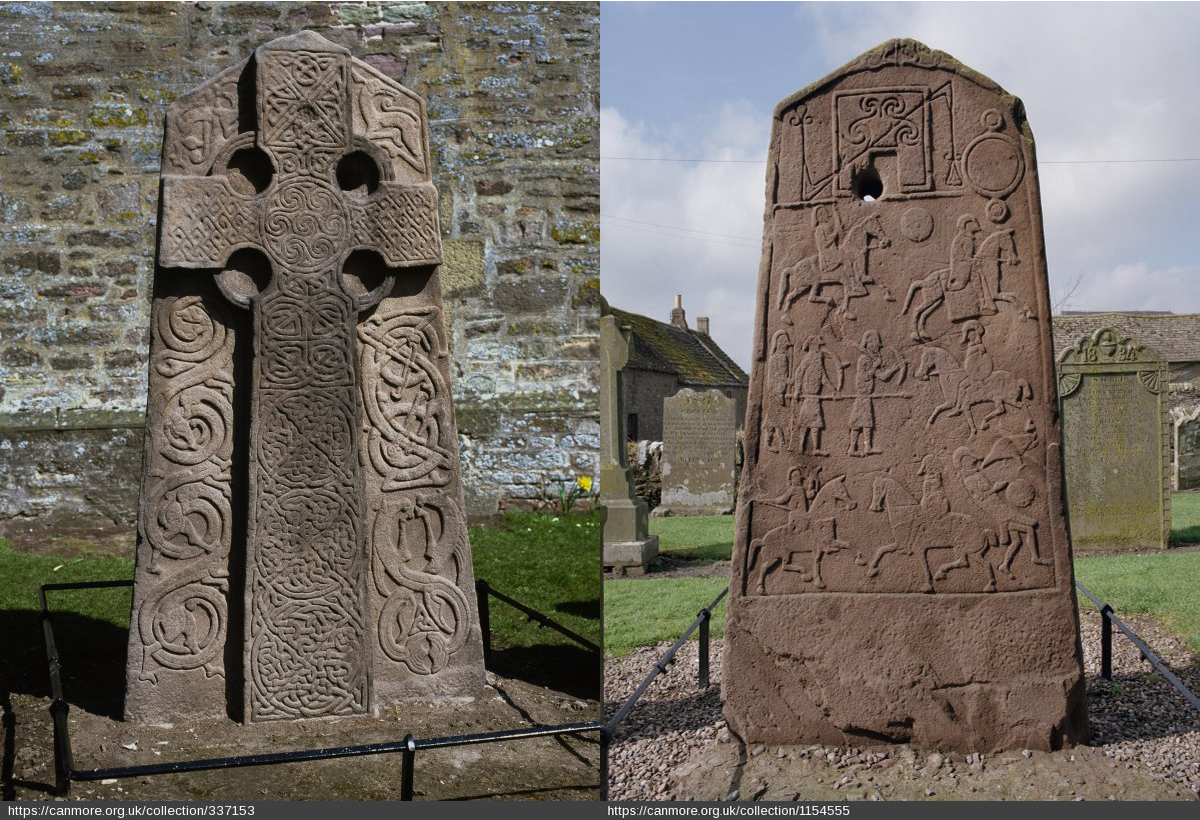
There are, however, two main difficulties in interpreting these Pictish symbol stones, though there are many theories as to what they represent. First, we are not entirely sure what they were for. Scholars have debated the issue for the last half century, arguing that they were monuments marking important meeting places or boundaries, or that they were memorials to particular individuals, families, events, or even that they might have been political statements opposing the spread of Christianity in early medieval Britain. Inscriptions are not helpful for interpretation either. While ogham writing in Ireland and Wales is found on stones that include Latin inscriptions, so that each stone is like a Rosetta Stone (with the Latin inscription in each case serving as a key to interpreting the ogham text), we do not currently have such a direct method of interpreting Pictish ideograms.
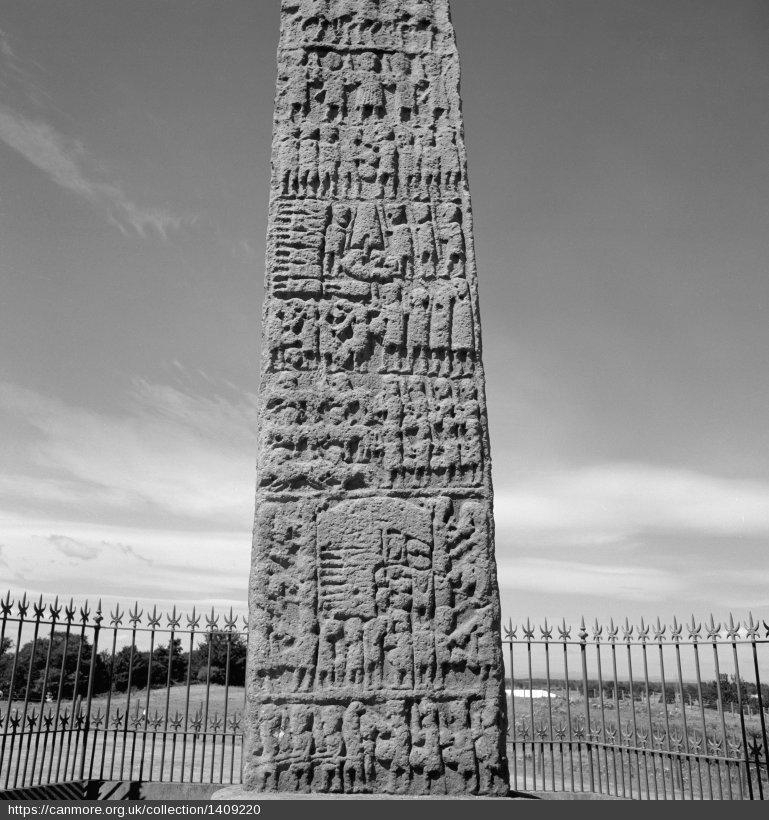
The second problem is the dating. Surviving Pictish stones suggest a development from the simple, presumably pagan, Pictish animals and shapes of Class I stones to the elaborate crosses in Class III. Like much archaeological evidence from the post-Roman fifth and early-sixth centuries in Britain, this dating is often based upon our expectations affected by early medieval texts like Bede’s Ecclesiastical History or Gildas’s On the Ruin of Britain, none of which were written in Britain in the period they describe. Unlike human or plant remains, stones cannot be radiocarbon dated. Even if we wanted to make the attempt at dating, for example, organic elements of the soil beneath the stones, only a few of the stones are actually still in situ. So the dating of the Pictish stones depends on parallels in manuscripts such as the Book of Durrow, and upon what we currently think about the history of the arrival of Christianity in Scotland. Even if we were able to determine with absolute certainty when exactly these stones were first inscribed and placed in the landscape, that account would still not consider the many succeeding generations and their many possible uses for these stones.
The Pictish stones in the Index of Medieval Art, especially the Class I stones, are part of a wider discussion of very early medieval society in Scotland. The Picts are the people that sixth-century and later texts blame for the beginning of the end of Roman Britain. Their raids along coasts to the south created defensive problems at a time when the Roman military presence in Britain was declining. Over the last fifty years or so, archaeological excavations of cemeteries in Scotland have increased our understanding of the monumental commemorations of death among the people who raised these decorated stones and crosses. The iconography on the stones that these people left behind is one of the few sources that modern scholars can work with to learn about the Picts and their world — and it also turns out to be a great source of inspiration for science fiction television.
This guest blog post was written by Janet Kay, a CLSA-Cotsen postdoctoral fellow at the Princeton Society of Fellows. She studies the history of fifth-century Britain, looking at burial practices to study a period for which there are no surviving texts. Janet uses material culture and funerary rites as primary sources to explore how fifth-century communities understood themselves and their newly-arrived neighbors from the continent and how invested they were in maintaining connections with their Roman past.
The Index invites paper proposals for two sessions at the 2018 Medieval Congress in Medieval Studies at Kalamazoo, on the theme of “Iconography and Its Discontents.”
Modern scholars often express discomfort with the term “iconography,” caricaturing its study as obsessed with rigidified taxonomies, elaborate stemmae, and the abstract pursuit of textual analogues for free-floating images. Yet the fundamental questions that drive iconographic studies remain central to scholarship in art history and many other medievalist disciplines. What did a medieval image mean, and to whom? How did these meanings change in different contexts and in the eyes of different viewers, and what can this tell us about the values and practices of the society in which they were made and viewed? The ways in which researchers answer these questions, meanwhile, has changed dramatically, bolstered by new methodologies and the increasing availability of digital tools to quantify, compare, and analyze a wide range of medieval images. Such advances suggest that the study of iconography not only is “not dead yet,” but is very much alive and open to reassessment.
Our two sessions capitalize on the new vitality of current iconographic studies by gathering papers that reexamine the potential of iconographic work for medievalists, prioritizing work that pushes past traditional approaches to engage with the new questions, new methods, new disciplines, and new technologies of greatest impact within the field. Following on the centennial and digital relaunch of Princeton’s recently renamed Index of Medieval Art, one of the first and longest-lived iconographic repositories of its kind, the session aims to chart a new path in a scholarship transformed by both technological advancements and disciplinary creativity.
Session I: Iconography and/as Methodology. What questions do today’s scholars ask of medieval images, and what approaches do they take to answering them? Do their efforts represent a break with the past or a continuation of it? What disciplines do they most engage? For this panel, we invite papers that explore the impact of new methods, whether from art history or from other disciplines, on modern understanding of how medieval images did their work for their makers and viewers. Papers that assess the relevance or revision of past approaches are also welcome.
Session II: Iconography and Technology. How have digital resources transformed the ways in which scholars approach the study of medieval images and their meaning? What new questions (and answers) are now possible, and what remains the same? For this panel, we seek papers that evaluate the impact of online collections, databases, and other digital tools on image-based scholarship in any discipline. Both case studies and broader analyses are invited.
Proposals are invited from scholars at all levels and in any relevant discipline. To submit, please send a Participant Information Form (https://wmich.edu/medievalcongress/submissions) and one-page abstract to:
Pamela A. Patton, Director
Index of Medieval Art
A7 McCormick Hall
Princeton University
Princeton, NJ 08544-1018

The month of June marks the passing of two historically consequential rulers: the fourth-century Roman emperor Julian, posthumously referred to as Julian the Apostate, and the twelfth-century Holy Roman Emperor Frederick I, also known as Frederick Barbarossa. Their untimely deaths shocked the Late Antique and Medieval worlds, respectively. On June 26, 363, Julian was mortally wounded in the battle of Samarra during a Roman military campaign against the Persians. According to various sources, a spear delivered by a member of the Sassanian cavalry pierced his liver, and he subsequently died from the mortal blow some three days later. June 10, 1190, marks the day on which Frederick Barbarossa drowned in the Saleph River (the Göksu in modern Turkey) in the middle of the Third Crusade, the Latin West’s attempt to recapture the Holy Land from Saladin. The deaths of both leaders in the middle of critical military campaigns generated either anxiety or derision among their contemporaries, as underscored in subsequent medieval representations of the two emperors.
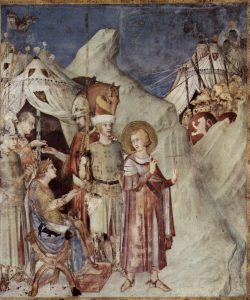
Posthumous medieval representations of Julian, the last Roman emperor who championed paganism, are almost always critical. For example, a lavishly illuminated ninth-century Byzantine manuscript of Gregory Nazianzen’s homilies (Paris, BnF, gr.510, fol. 374v), depicts the ruler accompanying the pagan philosopher Maximus of Ephesus and venerating idols. In Simone Martini’s fourteenth-century fresco cycle in the Chapel of Saint Martino within the Lower Church of San Francesco in Assisi, the figure of Julian the Apostate serves as an arrogant, pagan, visual foil to the saintly Martin of Tours, who is shown renouncing military life for his Christian beliefs. Depictions of Julian’s death are even more damning. By the early sixth century, accounts surrounding Julian’s death shifted away from a battle against the Persians and amplified the legend of Saint Mercurius (identified as Mercurius of Caesarea in the Index database), a Byzantine soldier saint who rises from the dead and kills the pagan emperor with his lance or sword.

Although this legend developed in Eastern sources, it grew in popularity in the Medieval Latin West, even making an appearance in Jacopo de Voragine’s thirteenth-century Golden Legend. In a fourteenth-century Christherre-Chronik miniature in the Morgan Library (New York, PML, M.769, fol. 327v), the figure of Julian is portrayed as an elderly medieval monarch lanced by a fully armored Saint Mercurius astride a galloping horse.

In contrast to the overwhelmingly uncomplimentary medieval portraits of Julian the Apostate, representations of Frederick Barbarossa generally evoke the idea of imperial majesty and power. The so-called Cappenberg head (c. 1160), a reliquary that originated as a portrait of Frederick, effectively conveys an image of grandeur and stability through its precious materials and antique visual language. Yet a miniature drawn, less than a decade after his death, in Peter of Eboli’s De Rebus Sicilis (Bern, Stadtbibliothek, 120 II, fol. 107r) betrays the unease surrounding the emperor’s accidental passing. Inscribed FREDERICUS IMPERATOR IN FLUMINE DEFUNCTUS, the drawing depicts the ruler falling off his horse and drowning in the water, his crown lying ignobly in the riverbed. As if to combat the contemporary whispers that Frederick died without confessing his sins, the illuminator purposely included an image of the ruler’s soul as a swaddled infant held aloft by an angel and given to the Hand of God emerging from heaven. In so doing, the artist was participating in a larger, concerted effort to salvage Frederick Barbarossa’s reputation for posterity as a noble and most Christian emperor.
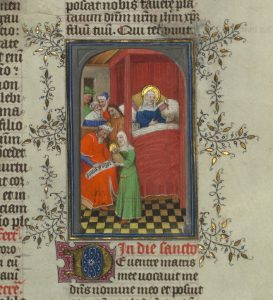
Zacharias writing John’s name at his nativity, Missal of Eberhard von Greiffenklau (Walters MS W. 174, fol. 191r)
Over the next few weeks, friends and users of the Index will see signs of our gradual shift to a new name, The Index of Medieval Art. This revision was undertaken after careful thought and consultation with Princeton faculty, students, administration, and the wider scholarly community.
The change reflects the broad evolution of our institution’s scope and mission since its founding in 1917, when its work was limited to cataloguing religious themes and subjects in early Christian art up to 700 C.E. A century later, our records have expanded to encompass both religious and secular imagery, including Jewish and Islamic works, from the first centuries of the Common Era until the sixteenth century. The scholarly activities that we support and generate have also evolved over the years, reflecting the broad interpretive and interdisciplinary analysis that has become fundamental to the study of medieval images. Our new name signals more accurately our expanded holdings, mission, and goals, as well as our institution’s broad potential to serve researchers in multiple fields of study.
If you have already bookmarked our Facebook and Twitter accounts using their original URLs, you’ll be redirected to the correct ones and shouldn’t notice an interruption. The new URLs for the sites appear below. In the coming months, we will also implement new URLs for this website and our redesigned database, which is set to launch in September 2017. We look forward to sharing news of those changes with you soon!
Facebook: www.facebook.com/imaprinceton/
Twitter: @imaprinceton
While the other months of the year had specific harvesting tasks associated with them, the relative ease of May was a welcome relief from the daily toil that dominated medieval life. May occupations are traditionally represented as more joyous, particularly in Books of Hours and Psalters. The Index database records over 180 scenes for May in manuscripts, and a little over half of them use the occupation of the male falconer on horseback (see related subjects: Month, Occupation: May; Figure, Male: Falconer; Horseman: Falconer; and Scene, Sports and Games: Falconer). Falconry, or Hawking, was a favorite medieval sport enjoyed especially at the beginning of spring. These hunting birds were prized for their agility and loyalty to their masters. Another popular scene depicting May is a pair of lovers on horseback, occasionally with a bird perching on the man’s wrist. This scene of a riding couple was a favored occupation and signaled the readiness for new courtships. Other instances of May scenes include figures holding flowers or wreaths, couples promenading, and other verdant scenes of courtship, whether amid blooms in grassy gardens or even on boats (see related subject: Scene, Secular: Courting).
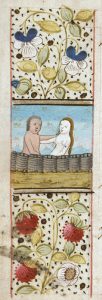
The zodiac sign that commences in May is Gemini, traditionally represented by a pair of figures—Gemini being Latin for “twins”—that are linked to their astrological appearance in the sky (see related subjects: Zodiac Sign: Gemini and Constellation: Gemini). The representations of Gemini can also be divided into a few main categories. A sample of about 80 French medieval manuscripts reveals that the most popular Gemini sign was the embracing nude couple, with far fewer of them appearing clothed. Often the couple’s bodies are masked by parts of the landscape or are cropped by a frame. Nude twins are the second most common Gemini sign and are usually depicted as two men embracing or wrestling. Sometimes the twins will appear as confronted soldiers with mirrored weapons and gear. The twin variations in Gemini also include pairs with crossed legs, conjoined bodies, or even one figure with two heads.

The subjects for months and zodiac signs are most prevalent in manuscripts, but they are also well-represented in sculpture such as the famous façades at Chartres and Vézelay. In 2007, information on all zodiac and occupation subjects classified by the Index was collected and published with Penn State University Press as Time in the Medieval World: Occupations of the Months and Signs of the Zodiac in the Index of Christian Art. This book has been hailed as a “lavishly illustrated” and “functional research tool” for studying the subject of the medieval measuring of time.
Hourihane, C., ed. Time in the Medieval World: Occupations of the Months and Signs of the Zodiac in the Index of Christian Art. University Park, PA: Penn State University Press, 2007.
Neal, K. “Time in the Medieval World: Occupations of the Months & Signs of the Zodiac in the Index of Christian Art (review).” Parergon, vol. 25 no. 2, 2008, pp. 164-166.
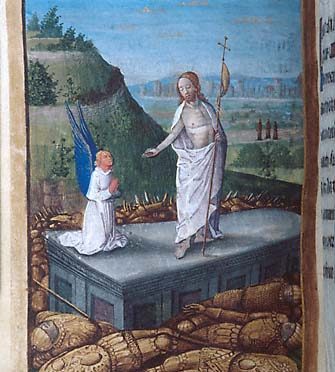
From the Gospel of Matthew, 27:62-66, Douay-Rheims: And the next day…the chief priests and the Pharisees came together to Pilate, saying: Sir, we have remembered, that that seducer said, while he was yet alive: After three days I will rise again. Command therefore the sepulchre to be guarded until the third day: lest perhaps his disciples come and steal him away, and say to the people: He is risen from the dead; and the last error shall be worse than the first. Pilate saith to them: you have a guard; go, guard it as you know. And they departing, made the sepulchre sure, sealing the stone, and setting guards.
Of the four Evangelists, Matthew alone records the above conversation among Pilate, the chief priests and the Pharisees, the latter two being concerned that Christ would emerge from the tomb to continue stirring up the people. To which Pilate responded, well, then guard the tomb. He had already washed his hands of the matter, yet here it is again. So, just guard the tomb, and (reading between the lines) leave me out of it. This episode also appears in the apocryphal gospel of Peter, where the story follows the same thread.
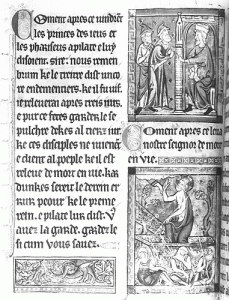
1. Miscellany, 1280-1299, Cambridge, St. John’s College, MS K.21. The upper image shows two high priests or Pharisees before Pilate expressing their concern that the tomb be guarded. Below, Christ stands in a sarcophagus; three soldiers sit in front of it. The text in the left column relates the story.
Christ’s resurrection appears in the Index of Christian Art 500+ times in multiple media; the order to set the guard is represented only sixteen times. The Cambridge Miscellany (Fig. 1) presents the thread of the story well, with the text in the left column, and in the right, a miniature with two figures petitioning Pilate, above a resurrection image with soldiers.
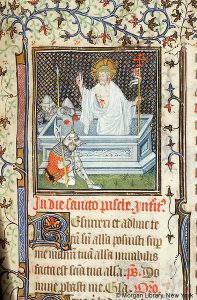
2. Châlons Missal, c. 1400, New York, Morgan Library, MS M.331, fol. 130r. Three soldiers surround a sarcophagus, one leaning on the back side of the tomb.
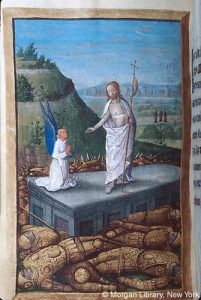
3. Hours of Anne of France, 1470-1480, New York, Morgan Library, MS M.677, fol. 200v. Many recumbent bodies wearing gold armor surround the tomb.
The number of soldiers present varies. Two, three or four are common (Fig. 2); examples exist with what appear to be small armies (Fig. 3).

4. Rheinau Psalter, c. 1250 Zurich, Zentralbibliothek MS Rheinau 167, fol. 107r. Three soldiers, with eyes open, two looking up at Christ, one pointing toward him.
Largely the soldiers are sleeping, but some are awake, looking up toward the risen Christ, sometimes shielding their eyes (Fig. 4).
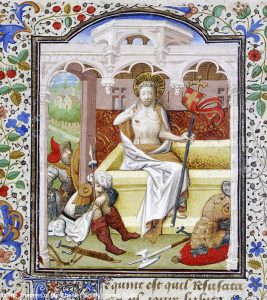
5. Coëytivy Hours, 1440-1449, Dublin, Chester Beatty Library MS W.82, fol. 342v. A soldier with his back turned rests comfortably on a red bolster with a gold tassel.
They wear chain mail or armor that is medieval, not Roman, which they would likely have been. Many are accompanied by weapons and shields, sometimes decorated with quasi-heraldic ornament. Some have creature comforts, such as a bolster to sit on, or a mattress to lie on (Fig. 5).
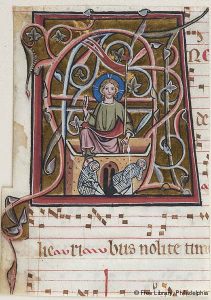
6. Antiphonary Fragment, c. 1300, Philadelphia Free Library MS Lewis EM 44.15. Christ steps from the tomb onto the neck of a sleeping soldier.
They pass the night at the tomb; they sleep even though Christ occasionally steps on them while climbing out of the tomb (Figs. 6 and 7); and they are still asleep when the three Marys, or Holy Women, arrive the next morning carrying ointment jars and sometimes censers.
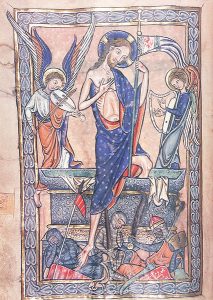
7. Missal of Henry of Chichester, c. 1250, Manchester, John Rylands University Library, MS lat. 24, fol. 152v. Christ steps on one of two dark-skinned soldiers asleep before the tomb.
Signs of “otherness” appear: a distorted face with a pig-like snout for a nose; knotted headdresses; curved swords or scimitars; dark skin (Fig. 7). The tomb itself may be a plain sarcophagus; or it may look more like a medieval shrine, with openings in the base.
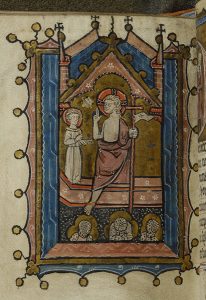
8. Psalter, c. 1290, New York, Morgan Library, MS M.34, fol. 187v. Each of three soldiers is tucked into an opening below the tomb.
Instead of pilgrims trying to get closer to the relics inside, the soldiers use those openings for cozy sleeping spaces (Fig. 8).
Judith K. Golden